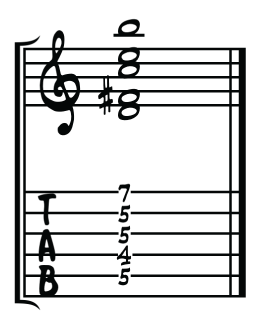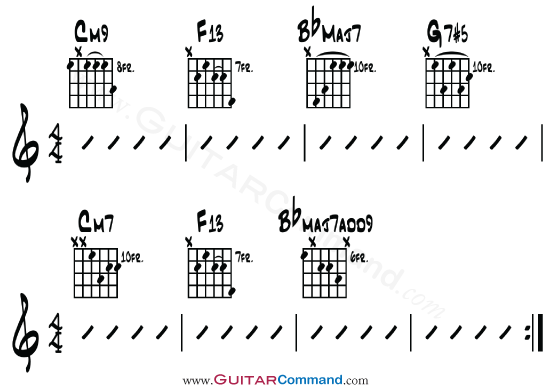A new series of Guitar Chord Of The Week begins with a dominant 13th chord shape. Learn it, play the example chord progression, then use it in your own songs!
Dominant 13th Chord Shape
This dominant 13th chord shape is a bit tricky to play if you aren't used to this kind of chord. However, once you start using it regularly it will actually become one of the easier chords. It's a nice sounding chord, and worth persevering with.
The main difficulty with this chord is the 'barre' made with the 3rd finger. Most guitarists are used to fretting more than one note with their 1st finger when they play conventional barre chords. Using the 3rd finger to hold down more than one note can feel a bit strange at first.
You may have to bend the tip of the third finger back slightly so that it holds down both of the notes. Remember that a good technique, rather than brute strength, is usually the key to producing clear guitar chords.
Use the example chord progression at the end of this article to practice moving to and from the chord.
13th Chord Construction
This 13th chord is based on the dominant 9th chord shape shown here. The only difference is that the little finger holds down the top note in the 13th chord shape.
A D13 chord, played using this week's shape, is shown below in tab.

[ad name="Google Adsense Lge Rec"]
How Many Notes?
As you will know if you have read the dominant chords article, unnecessary notes are often omitted from guitar chords.
Strictly speaking, a full 13th chord should contain seven different notes. This week's shape only contains five different notes: the 5th and the 11th have been omitted. Omitting notes is often necessary to allow certain chords to be played on the guitar: it's hard to play a seven note chord on an instrument with only six strings!
Example Chord Sequence

Try playing this cool jazz progression. It contains the 13th shape, as well as some other nice jazz chords. Take it very slowly at first if you are not familiar with the chords. Once you have got all of the chords 'under your fingers', play the progression with a suitably 'jazzy' strumming pattern.
[ad name="Google Adsense Lge Rec"]



Your G7#5 chord has both a “d” note (4th string, 12th fret) as well as the “d#” note. You can either mute out the string or slide the note up another fret.
Your BbMaj7add9 is really a BbMaj7add6 (the note on the B string, 8th fret, is “g”). To play a BdMaj7add9, you could play the “c” note on the top E string, 8th fret and mute out the B string. Both BbMaj7add6 and BbMaj7add9 chords sound “jazzy”